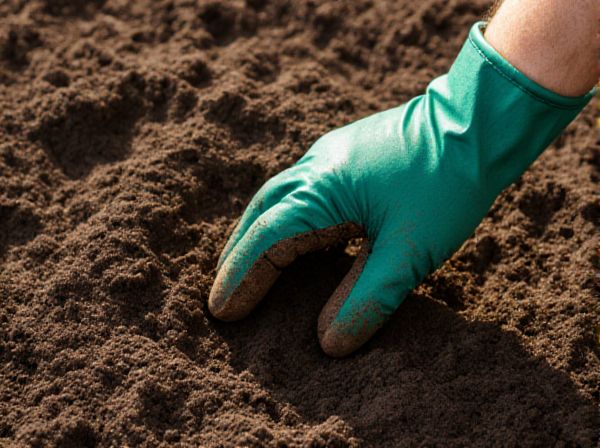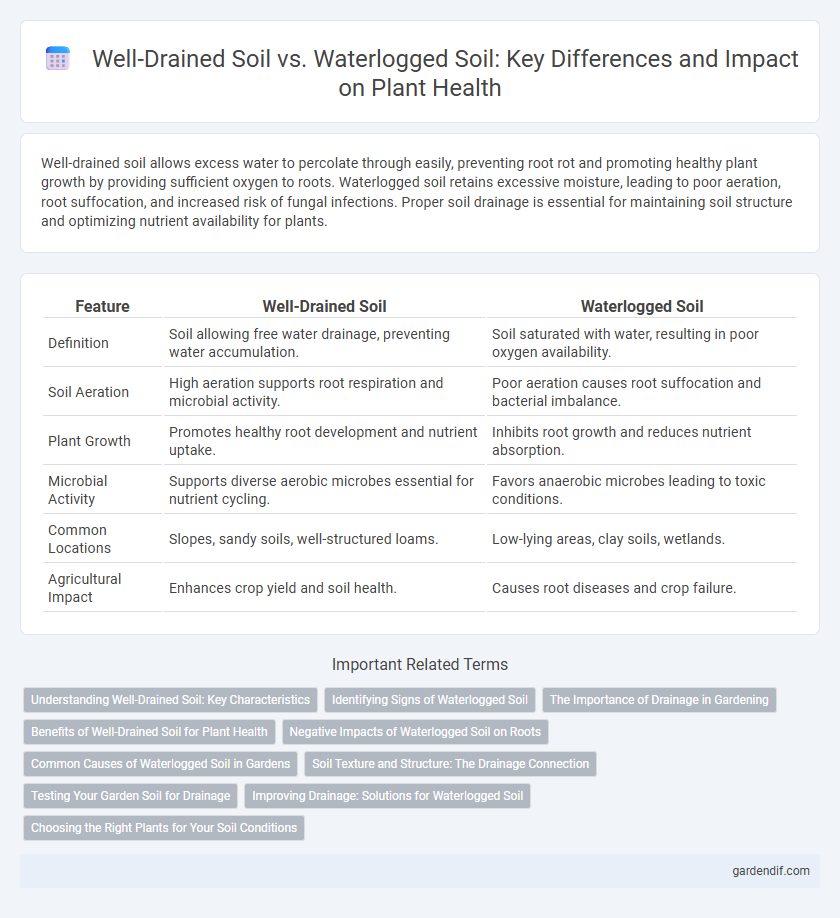
Well-drained soil vs Waterlogged soil Illustration
Well-drained soil allows excess water to percolate through easily, preventing root rot and promoting healthy plant growth by providing sufficient oxygen to roots. Waterlogged soil retains excessive moisture, leading to poor aeration, root suffocation, and increased risk of fungal infections. Proper soil drainage is essential for maintaining soil structure and optimizing nutrient availability for plants.
Table of Comparison
| Feature | Well-Drained Soil | Waterlogged Soil |
|---|---|---|
| Definition | Soil allowing free water drainage, preventing water accumulation. | Soil saturated with water, resulting in poor oxygen availability. |
| Soil Aeration | High aeration supports root respiration and microbial activity. | Poor aeration causes root suffocation and bacterial imbalance. |
| Plant Growth | Promotes healthy root development and nutrient uptake. | Inhibits root growth and reduces nutrient absorption. |
| Microbial Activity | Supports diverse aerobic microbes essential for nutrient cycling. | Favors anaerobic microbes leading to toxic conditions. |
| Common Locations | Slopes, sandy soils, well-structured loams. | Low-lying areas, clay soils, wetlands. |
| Agricultural Impact | Enhances crop yield and soil health. | Causes root diseases and crop failure. |
Understanding Well-Drained Soil: Key Characteristics
Well-drained soil features a balanced texture with sufficient sand, silt, and clay particles that promote efficient water infiltration and prevent water retention. It maintains optimal aeration, supporting root respiration and microbial activity essential for plant growth. This soil type typically exhibits a crumbly structure, moderate organic content, and a neutral to slightly acidic pH, ensuring nutrient availability and minimizing root diseases commonly associated with waterlogged conditions.
Identifying Signs of Waterlogged Soil
Waterlogged soil is characterized by persistent surface pooling and a sour or musty odor due to anaerobic conditions limiting oxygen availability for roots. Plants growing in these soils often exhibit yellowing leaves, stunted growth, and wilting despite adequate moisture. Additionally, soil texture becomes compacted and muddy, losing its crumbly structure typical of well-drained soils.
The Importance of Drainage in Gardening
Well-drained soil enhances root oxygen availability and prevents harmful pathogen buildup, promoting healthy plant growth. Waterlogged soil restricts air circulation, leading to root rot and nutrient deficiencies. Effective drainage management is crucial for maintaining optimal soil structure and sustaining vibrant garden ecosystems.
Benefits of Well-Drained Soil for Plant Health
Well-drained soil enhances root oxygenation and prevents the accumulation of harmful pathogens, promoting robust plant growth and nutrient uptake. This soil type reduces the risk of root rot and supports beneficial microbial activity essential for nutrient cycling. Plants in well-drained soil exhibit increased resilience against stress conditions and improved overall health compared to those in waterlogged environments.
Negative Impacts of Waterlogged Soil on Roots
Waterlogged soil severely restricts oxygen availability to plant roots, causing root suffocation and impairing nutrient uptake. Prolonged exposure to excess moisture fosters root diseases such as root rot, which weaken plant stability and reduce growth. In contrast, well-drained soil promotes healthy root development by maintaining adequate aeration and preventing toxic buildup from anaerobic conditions.
Common Causes of Waterlogged Soil in Gardens
Waterlogged soil in gardens commonly results from poor drainage due to compacted clayey soil, heavy rainfall, or inadequate soil structure that prevents water infiltration. Low-lying areas with a high water table also contribute to persistent soil saturation, reducing oxygen availability for plant roots. Improper irrigation practices and blocked drainage systems exacerbate water accumulation, leading to root decay and poor plant health.
Soil Texture and Structure: The Drainage Connection
Well-drained soil typically exhibits a balanced texture with a mix of sand, silt, and clay particles that create larger pore spaces, promoting efficient water infiltration and aeration. Waterlogged soil, often characterized by a higher clay content and compacted structure, restricts water movement due to tiny pores that retain excess moisture and reduce oxygen availability to roots. Soil structure, including aggregation and porosity, directly influences drainage capacity, making texture and aggregation critical factors in preventing waterlogging and ensuring healthy root growth.
Testing Your Garden Soil for Drainage
Testing your garden soil for drainage involves digging a hole about 12 inches deep and filling it with water, then observing how quickly the water drains. Well-drained soil generally allows water to percolate within 1 to 2 hours, preventing root rot and promoting healthy plant growth. Waterlogged soil drains slowly or not at all, which can suffocate roots and lead to poor plant health.
Improving Drainage: Solutions for Waterlogged Soil
Improving drainage in waterlogged soil involves techniques such as installing French drains, creating raised beds, and incorporating organic matter like compost to enhance soil structure and permeability. Installing perforated pipes beneath the surface effectively channels excess water away, preventing root rot and nutrient depletion. Regular aeration and the use of sand or gravel amendments also promote faster water infiltration, transforming waterlogged soil into well-drained soil suitable for healthy plant growth.
Choosing the Right Plants for Your Soil Conditions
Well-drained soil supports the growth of drought-tolerant plants such as lavender, rosemary, and succulents, which thrive in air-rich environments and prevent root rot. Waterlogged soil benefits moisture-loving plants like cattails, water lilies, and willows that can tolerate or thrive in saturated conditions with low oxygen levels. Selecting plants based on soil drainage conditions optimizes growth, plant health, and garden sustainability.
Well-drained soil vs Waterlogged soil Infographic

 gardendif.com
gardendif.com